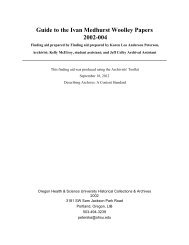1962;29;121-128 Pediatrics T. Berry Brazelton A CHILD-ORIENTED ...
1962;29;121-128 Pediatrics T. Berry Brazelton A CHILD-ORIENTED ...
1962;29;121-128 Pediatrics T. Berry Brazelton A CHILD-ORIENTED ...
Create successful ePaper yourself
Turn your PDF publications into a flip-book with our unique Google optimized e-Paper software.
124 TOILET TRAINING<br />
ond time during the day. This can be after<br />
his diapers are soiled, to change him on<br />
the seat, dropping his dirty diaper under<br />
him into the pot, and pointing out to him<br />
that<br />
chair.<br />
this is the eventual function of his<br />
When some understanding and wish to<br />
comply coincide, there will be verbal or<br />
active compliance on the first routine trip.<br />
Then he can be taken several times a day<br />
to “¿catch†his urine or stool, provided he<br />
remains willing.<br />
As interest in performance grows, the<br />
next major step becomes feasible. All dia<br />
pers and pants are removed for short<br />
periods, the toilet chair is placed in his<br />
room or play area, and his ability to per<br />
form by himself is pointed out. He is en<br />
couraged to go to his own pot when he<br />
wishes and by himself. He may be reminded<br />
periodically that this is indicated. When he<br />
is ready to perform alone, this becomes an<br />
exciting accomplishment, and many chil<br />
dren take over the function entirely at this<br />
point. Training pants can be introduced,<br />
the child instructed as to their removal, and<br />
they become an adjunct to his autonomous<br />
control. The excitement which accom<br />
panies mastering these steps by himself is<br />
well worth the postponing until he can<br />
accept them.<br />
Teaching a boy to stand for urination is<br />
an added incentive. It becomes a part of<br />
identifying with his father, with other boys,<br />
and is often an outlet for a normal amount<br />
of exhibitionism. It is most easily learned<br />
by watching and imitating other male fig<br />
ures. It is better introduced after bowel<br />
training is complete. Otherwise, the excite<br />
ment<br />
sedes.<br />
of standing for all functions super<br />
Nap and night training are left until<br />
well after the child shows an interest in<br />
staying clean and dry during the day. This<br />
may be 1 to 2 years later, but it often be.<br />
comes coincident with daytime achieve<br />
ment. When the child evidences an interest<br />
in night training, the parent can offer to<br />
help him by rousing him in the early eve<br />
ning and offering him a chance to go to the<br />
toilet. A pot painted with luminous paint<br />
by his bedside is often a useful “¿gimmick.â€<br />
He is reminded that this is there for early<br />
morning use also. Some children who are<br />
eager and ready to remain dry at night<br />
have needed further help from the parents<br />
to awaken in the early morning for an in<br />
terval. When this is not forthcoming, they<br />
fail in their efforts at night, lose interest<br />
and feel guilty in their failure. Then, enure<br />
sis and “¿giving upâ€may follow.<br />
These steps are stressed as the child's<br />
achievement, and when there is a break<br />
down the parent is urged to stop the proc<br />
ess and to reassure the child. He needs the<br />
reassurance that he is not “¿bad†in his<br />
failure to achieve, and that someday he<br />
will co-operate when he is “¿ready.â€<br />
RESULTS<br />
The results are compiled from unselected<br />
records of 1,170 patients over 10 years of<br />
pediatric practice ( 1951-1961) in Cam<br />
bridge, Massachusetts. Upper-middle-class<br />
well-educated parents comprised the major<br />
portion of patients in this group. They lived<br />
under economic pressure, and mothers were<br />
washing their own diapers, so there was<br />
some practical pressure to achieve training.<br />
But their desire to give their children a<br />
thoughtful environment freed them in most<br />
cases<br />
method.<br />
to want to follow the suggested<br />
The sample consisted of 672 (57.4%) male<br />
and 498 (42.6%) female children, of whom<br />
660 (56.4%) were first children and 450<br />
(43.6%) weresecondorlater.It wasfound<br />
that the position in the family was a factor<br />
in determining the kind of environmental<br />
pressure which existed. With the first child<br />
there was usually more anxiety shown by<br />
the parents about waiting to train the child,<br />
more ambivalence about this “¿delayedâ€<br />
method, but surprise and relief when train<br />
ing was accomplished. The later children<br />
were given more freedom to train them<br />
selves at their own speed. However some<br />
pressure on these later children to conform<br />
came from the older siblings. Imitation of<br />
the older children often facilitated training<br />
in the younger ones.<br />
The daytime training of first children<br />
Downloaded from<br />
www.pediatrics.org by Cynthia Ferrell on April 15, 2011
















